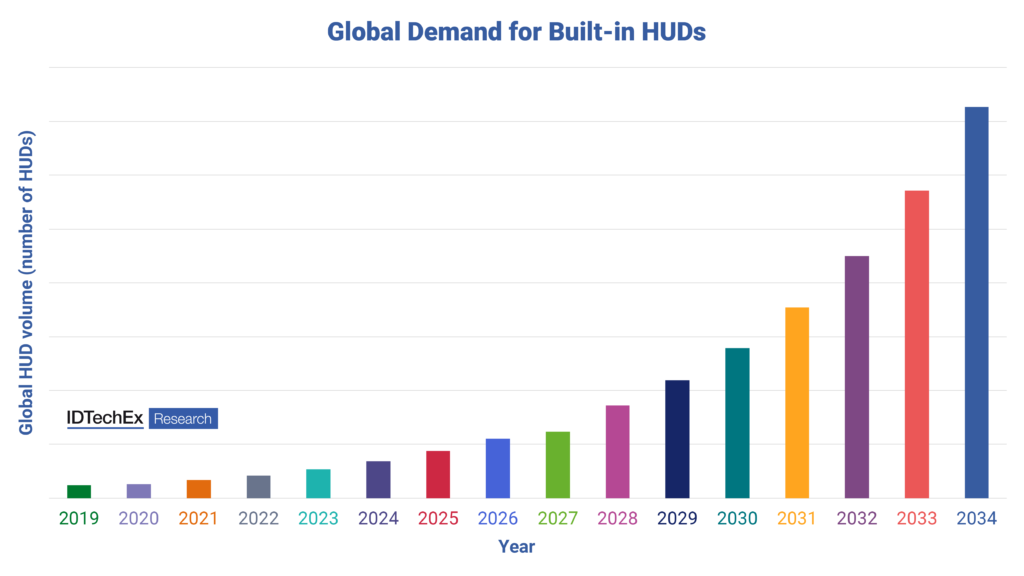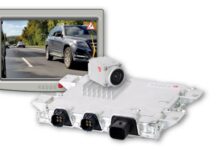The rise in vehicle autonomy is expected to bring revolutionary technology to the automotive display sector. It will bring a shift in focus from OEMs, enhancing passenger entertainment on-board and increasing the number of displays capable of delivering a more immersive experience via augmented reality (AR). While this sounds very futuristic, OEMs are designing concepts that could bring these AR solutions to market sooner rather than later.
IDTechEx’s “Automotive Displays 2024-2034: Technologies, Players, Opportunities” report provides a comprehensive coverage of this display sector, from the most renowned 2-dimensional technologies to the more futuristic 3-dimensional imaging techniques. This report also covers key trends, market analysis, opportunities, and granular 10-year forecasts for display volume (number of displays) and value (US$), segmenting the industry by display type and technology.
There are two key technologies that enable true 3-dimensional imaging: Light field displays (LFDs) and computer-generated holography (CGH). But what is meant by true 3-dimensional imaging?
Unlike 2D or conventional stereoscopic techniques, the aforementioned 3D technologies offer the viewer true depth cues to the objects it displays. The successful release of 3D imaging depends on these mechanisms’ success, and the current use of stereoscopic alternatives will continue to delay its positive introduction to the market. LCDs and OLEDs, for instance, are currently being used in a stereoscopic manner, delivering one image (one perspective) to one eye and a slightly different one to the other eye. They also induce a “parallax effect”, where a 3-dimensional effect is given to viewers by making background images move slower than images in the foreground. All these techniques are illusions and are a reason why stereoscopic 3D technology has so far not been successful in reaching the mass market. Most people cannot use these devices for extended periods of time, and the reason is known more technically as “vergence-accommodation conflict” (VAC).
VAC is caused by the disparity of distances between the virtual object and the eye and the eye with the stereoscopic screen. If a virtual image, for instance, is presented 3m away from the eye, but the eyes are focusing on a screen a few centimeters away, this distance mismatch will cause the user discomfort, particularly if the images are moving fast.
For this reason, several display companies are studying the use of true 3D technology, such as LFDs and CGH. But is there a use for them in automotive?
The market is heavily populated and dominated by LCDs, followed by OLEDs. These are mature technologies, and in an industry that requires stringent and rigorous testing, any novelty in this regard may be ill-advised for the time being. That being said, not all displays are equal or have the same requirements. For example, computer-generated holography (CGH) is seriously considered a viable option for heads-up displays (HUDs). HUDs are actively being used in airplanes, helping guide pilots during flights and providing valuable insights and information directly to their line of sight. HUDs in automotive are images projected directly to a combiner, placed ahead of the driver, or directly to the windshield. While covering the windshield is naturally hazardous, annotating and signaling key areas of concern on the road is valuable, and there is a balance to strike between how much annotation is possible in this application. HUDs are expected to grow in the foreseeable future, and the main driver for this growth is safety-related. Drivers must currently deviate their gaze from the road to check the information presented on the dashboard and the GPS on the center information display (CID), and this can impact passenger safety on board. Heads-up displays will present information directly to the user’s line of sight, eliminating this issue and helping drivers focus more on the road.

There are two main reasons why CGH holography is considered for this application. The first is its capability to display virtual images with true depth cues and without loss in resolution. The driving experience is significantly more comfortable when objects in the road are annotated with images with varying depth cues and can provide the driver with more helpful guidance.
The second reason is its brightness. CGH requires a highly coherent light source, typically a laser, and naturally, these are very bright sources, much brighter than alternative display technologies in the market. Brightness is fundamental in HUDs since direct sunlight is naturally often incident on the automotive windshield. LCDs and OLEDs currently find it difficult to display images when the ambient illumination levels are very high. In HUDs, this can be problematic since important driving information is displayed in this area, and it is imperative that the driver can view this under any circumstances. The brightness levels seen in holography are very high, and information is displayed clearly on the combiner or windshield.
Despite growing interest in adopting this display technology for HUDs, there are limitations that are hindering its introduction to the mass market. The main one is related to cost. Companies in this field are targeting premium vehicles, and there are a couple of reasons for this, but the cost is the fundamental one. The cost of introducing this technology is more expensive than the more mature TFT-LCD technology. Given the average profit margins seen by OEMs in the automotive sector, approximately 7.5%, the average vehicle cannot afford to include this novel technology. With technology maturity, it is expected this cost will go down; however, it is naturally unlikely it will compete with TFT-LCDs when it comes to cost.
The other reason these companies are targeting premium vehicles is related to form factor. Most premium vehicles tend to be larger in size and, therefore, can accommodate larger components within the vehicle. The current product lines from these companies are generally larger than their TFT-LCD counterparts, and these are difficult to fit in smaller vehicles.
Despite notable benefits to this technology, it is not currently considered a viable option in other applications, and this is due to its comparatively poorer image quality when compared to mainstream display technologies, LCDs, and OLEDs. An effect known as speckle is inherent in this system and is identified as a fine granular pattern projected with the virtual image. While in the HUD space, the use of this technology as a high brightness annotating mechanism and its reduced reliance on its image quality could impact its successful launch in the market, other industries are more reliant on image quality when focusing on entertainment, for instance. The center information display (CID) has more entertainment features than other displays in the vehicle; therefore, holography would be ill-advised in this case.
It will take some more years to finally see true 3-dimensional images in our surroundings, but for some applications, it may be sooner rather than later. IDTechEx’s report, “Automotive Displays 2024-2034: Technologies, Players, Opportunities”, offers a comprehensive analysis of the display technologies impacting the automotive sector in the coming decade, alongside an evaluation of the future trends and opportunities impacting this market. With the shift towards greater vehicle immersiveness expected with the rise in vehicle autonomy, the market is forecasted to surpass US$ 27 billion by 2034.















